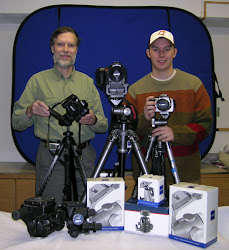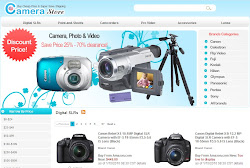Canon EOS D30 3MP Digital SLR Camera (Body Only) Review
A wonderful choice for advanced amateurs, especially those who already have EOS lenses and flashes. The resolution is high enough for any consumer application, and the firmware updates from Canon solve many earlier glitches.
Canon EOS D30 3MP Digital SLR Camera (Body Only) Feature
- 3.3 megapixel sensor creates 2,160 x 1,440 pixel images for prints at 8 x 10 inches and beyond
- Compatible with all Canon EF lenses
- Compatible with all Canon EX-series Speedlite flashes
- Included 16 MB CompactFlash memory card holds 5 images at default resolution
- Connects with Macs and PCs via USB port; uses BP-511 lithium ion battery, included
Canon EOS D30 3MP Digital SLR Camera (Body Only) Overview
The Canon EOS D30 is one of the few available interchangeable-lens digital single-lens reflex (SLR) cameras. It's designed to offer the performance and picture quality of a film-based SLR with the convenience and features of a digital camera. Based on Canon's EOS line of film cameras, the D30 is compatible with all EOS-related equipment, including EF lenses and EX-series Speedlite flashes. This model is targeted at "prosumers" (serious consumers and some professionals), and its EOS compatibility makes it a natural choice for people who already own Canon equipment.
If you're accustomed to using a Canon SLR, the D30's features and controls will be familiar. As with film models, the shutter speed, aperture, and focus can all be set manually or automatically. White balance can also be adjusted, either by selecting a preset value or by shooting and storing a reference image. Unlike most digital cameras, the traditional optical viewfinder is the only way to frame your shots; the 1.8-inch LCD monitor on the back of the camera is for perusing images and adjusting settings only. One bonus of this arrangement is that the D30 is always ready to take pictures; you don't have to worry about changing modes as you must on most digital cameras.
The introduction of the D30 also marks the first use of a CMOS sensor in a multimegapixel digital camera. Because CMOS sensors are less expensive, use less power, and are easier to manufacture than the traditional CCD sensors found on most cameras, there are high hopes that CMOS will be the primary sensor technology for the super-high resolution digital cameras of tomorrow. Until now, however, CMOS sensors have offered inferior results when compared to CCD, so they've been found primarily in entry-level and toy digital cameras. Canon seems to have solved the image-quality problem by custom designing the CMOS chip in the D30, and the company claims that their sensor offers better performance than most CCD sensors.
Images are stored on Type I or Type II CompactFlash cards, including the IBM Microdrive. By default, files are recorded in JPEG format, though there are also settings for TIFF and RAW recording. TIFF is the most common lossless recording format, and TIFF images can be viewed and edited with virtually any photo editing software. TIFF files provide the highest-quality images, but at a price: a single D30 image occupies nearly 10 MB of memory. RAW, in contrast, is a newer format that's not recognized by as many photo-editing software packages, though Canon provides a plug-in to let Adobe Photoshop users directly import RAW files, and also includes software that lets you convert RAW files to TIFF files on your computer. Like TIFF, RAW is a lossless format, yet RAW files are only about one-third the size of TIFFs. Because the RAW image comes directly from the sensor and has received less in-camera processing than other file formats, it also offers experienced users more image-correction options.
A final note about the EOS D30. The CMOS sensor is smaller than a 35mm negative, which means that when you take a picture, the focal length of the lens you are using is greater. For example, if you took a picture using a lens with a 28mm focal length, the actual focal length would be 1.6x greater, or 45mm. If you're currently shooting with a Canon SLR, this makes your zoom lenses even more powerful, but it also means that you'll need to pick up a wide-angle lens or wide-angle converter to regain the range of focal lengths you have with film. --Michael Lewis and Shane Burnett
Pros:
- Compatible with all Canon EOS equipment.
- Features RAW mode for ultimate photographic control.
- SLR flexibility and control.
Cons:
- Expensive.
- Focal length adjustment makes wide-angle shooting difficult.
- More memory is the first accessory you'll need to buy.
Canon EOS D30 3MP Digital SLR Camera (Body Only) Specifications
CompactFlash Microdrive F/4.0-5.6The Canon EOS 400Ds 10.1 megapixel sensor employs the same outstanding CMOS image quality advantage of its big brothers in the professional EOS 1 range. Super sensitive in low light and virt
Available at Amazon Check Price Now!
*** Product Information and Prices Stored: Oct 18, 2009 18:43:04







0 comments:
Post a Comment